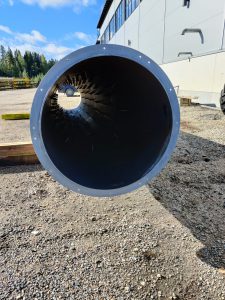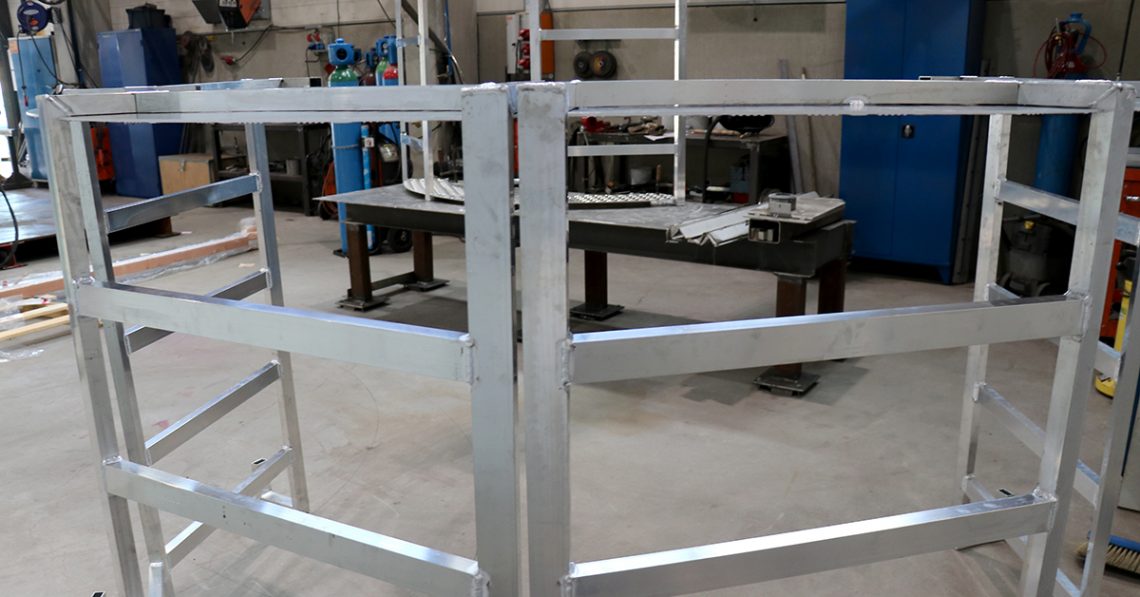We manufactured a coal processing furnace for Agnico Eagle Finland Oy in Kittilä. The furnace is made from fire-resistant 253MA material.

We manufactured a coal processing furnace for Agnico Eagle Finland Oy in Kittilä. The furnace is made from fire-resistant 253MA material.

The railroad wagon unloading station manufactured by Simetek allows for the flow of goods transported by Rauanheimo to be processed at Mussalo Harbour in Kotka. The station is part of significant investments aimed to drastically increase traffic at the harbour.
Once the transit traffic train arrives at Mussalo Harbour from Russia, it travels along the new tracks to the newly completed railroad wagon unloading station and easily unloads its cargo via the unloading funnel to a conveyor belt system deep underground. The conveyor transports the load to elevators which mechanically lift the load to the next conveyor. The products travel along the conveyor to harbour operator Rauanheimo’s warehouses.
The railroad wagons arriving at the unloading station carry fertiliser, but the product could just as easily be any other bulk cargo, such as flour or seeds.
“Demand for transit traffic has increased. Without this newly constructed unloading station, it would have been impossible to transport goods to the new warehouses,” explains project manager Timo Taavitsainen from Rauanheimo.
Simetek achieved its targets
Simetek initiated preliminary planning for the project a year ago. The plans had to pay close attention to the width and type of track, as well as for the depth of the excavation in which the conveyor would be placed. The work required collaboration from many actors during the planning and implementation phases in order for the overall project to be suitable for VR’s and Rauanheimo’s existing logistics and warehouse solutions at Mussalo Harbour.
“Coordinating the conveyor and elevators into the excavation required various actors to work together to get the material flow into the right position,” explains design manager Pasi Knuuttila from Simetek.
Simetek was responsible for the project’s mechanical engineering, the manufacturing of steel structures, and the installation of the equipment. It also manufactured and installed to protect the equipment.
“Simetek was able to outline the kind of equipment that would be able to transport the load to the warehouse well. The original models were slightly modified along the way, but Simetek always presented a functional solution for the conditions whenever modifications were necessary,” says Taavitsainen.
Simetek kept to the schedule and remained within budget, despite the large size of the project. Taavitsainen praises Simetek for sufficient resource allocation and good work management.
Installation and test runs were a success
Before installation, verifying measurements were carried out on the excavation. Then, Simetek erected the elevators and installed the conveyors and unloading funnels in place. It also installed the railroad wagon’s steel load beams and turned the third conveyor more than 180 degrees from its old position into its new place. Finally, Simetek erected the shelter it had manufactured to protect the unloading station.
“The installation went well as we knew what we had sold, designed, and manufactured. The overall entity was easy to manage. Our strength is that we provide all services from design to manufacture and installation under the same roof,” says Knuuttila.
After installation, the test runs also went well. Rauanheimo is satisfied with Simetek’s way of working.
“Simetek has been able to innovatively produce new solutions that support our business operations. Our collaboration has been constructive,” says Taavitsainen.
We manufactured a district heating line for Yara.

We manufactured aluminium maintenance platforms to improve safety during the customer’s maintenance work.

We machined the rotor and housing of a rotary feeder to be compatible with one another. Before machining, hard facing was applied to the rotor.

From vehicle inspection mechanic to designer
Three years ago, Matti Hirvonen left his job as a vehicle inspection mechanic to work as a mechanical designer for Simetek. His change of career was spurred on by his own interests: restoring and refurbishing machines, tractors, and cars. The skills and know-how he gained through his hands-on work combined with his engineering studies aided his transition to design work. Hirvonen also has some experience with the construction industry.
“I’ve welded and built all kinds of things with my dad in his shop ever since I was 13 years old. In design work, it’s really useful to know what steel to use when and where, and how it behaves when welding. When doing practical work, you also notice what problems might crop up during assembly. They don’t necessarily come to mind when you’re working at a computer,” says Hirvonen.
His experience working with steel means that occasionally you’ll find Hirvonen in the machine shop side of production. There he often works as a foreman, but also handles anything else that requires production. One of his most recent foreman tasks was the installation of a coarse crushed stone tipping cone with an eight-metre-diameter for a Yara mine.
“Another foreman task was implementing a crushing station built on to the trailer of a truck. I helped the installation engineers and welders as necessary, and assisted with assembly.”
One of Hirvonen’s favourite projects was the design of access and maintenance platforms to be installed at a height of 20 metres on a customer’s premises, which he handled independently from start to finish. He first visited the premises, laser scanned the site in question, and then completed the design work. Hirvonen most often begins work by laser scanning a site.
“Laser scanning provides dimensions and distances directly from the scanning data and you can really get hands-on with the interfaces, like walls and floors. That makes design work quicker and easier. Laser scanning also helps installation, since the environment around the device to be installed is always with you in models and drawings,” says Hirvonen.
One of his most challenging jobs was the design of elevators connected to railroad wagon unloading equipment for Oy Rauanheimo Ab at Mussalo Harbour, but he also succeeded in completing that job and the customer was very satisfied with the end result.
Hirvonen considers his change of career to have been a success. Every day I learn something new and keep my mind active, as my job requires me to continually develop. He also enjoys the cordial atmosphere at Simetek, where employees have a sense of humour even while they work.
“You can be yourself here, there’s no need to play a role. Everyone is really laid-back.”
Hirvonen lives in a detached house in Siilinjärvi together with his wife and 6-year-old son. He has also built a 65-square-metre building for his leisure-time projects, where he can spend time after work. Hirvonen is currently working on restoring one of Simetek’s old trucks. The truck is a 1969 model and the chassis is in such poor condition that it needs to be replaced almost entirely.
Our customer Oy Rauanheimo Ab has increased its operations at Mussalo Harbour at the Port of HaminaKotka. We manufactured and installed a railroad wagon unloading terminal as part of the project. Read Rauanheimo’s article on the topic: https://www.rauanheimo.com/en/2020/09/28/rauanheimos-new-wagon-unloading-terminal-in-mussalo/
Planning for the construction project to build a new unloading terminal began in spring 2019 and construction work began in November 2019. Handover took place in July 2020.
“The construction project itself progressed wonderfully and as planned. There were no problems at any stage, and it succeeded in sticking to the original schedule and budget,” says Niko Orpana, regional manager for South Finland at Rauanheimo.
A railroad wagon unloading funnel manufactured and installed by Simetek has now undergone testing and has been handed over to our customer Oy M. Rauanheimo Ab.
We manufactured a screw conveyor made of acid-resistant steel.


We manufactured a bark feeder pipe from chromium carbide sheeting. The bark feeder pipe will be used in a power plant where fuel will pass through it.